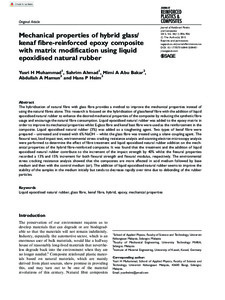Date
2015-04-27Subject
540 Chemistry 600 Technology NaturkautschukGlasfaserNaturfaserMechanische EigenschaftKenafHybrideEpoxideMetadata
Show full item record
Aufsatz

Mechanical properties of hybrid glass/kenaf fibre-reinforced epoxy composite with matrix modification using liquid epoxidised natural rubber
Abstract
The hybridisation of natural fibre with glass fibre provides a method to improve the mechanical properties instead of using the natural fibres alone. This research is focused on the hybridisation of glass/kenaf fibre with the addition of liquid epoxidised natural rubber to enhance the desired mechanical properties of the composite by reducing the synthetic fibre usage and encourage the natural fibre consumption. Liquid epoxidised natural rubber was added to the epoxy matrix in order to improve its mechanical properties whilst E-glass fibre and kenaf bast fibre were used as the reinforcement in the composite. Liquid epoxidised natural rubber (3%) was added as a toughening agent. Two types of kenaf fibre were prepared – untreated and treated with 6% NaOH – whilst the glass fibre was treated using a silane coupling agent. The flexural test, Izod impact test, environmental stress cracking resistance analysis and scanning electron microscopy analysis were performed to determine the effect of fibre treatment and liquid epoxidised natural rubber addition on the mechanical properties of the hybrid fibre-reinforced composite. It was found that the treatment and the addition of liquid epoxidised natural rubber contribute to the increment of the impact strength by 40% whilst the flexural properties recorded a 13% and 15% increment for both flexural strength and flexural modulus, respectively. The environmental stress cracking resistance analysis showed that the composites are more affected in acid medium followed by base medium and then with the control medium (air). The addition of liquid epoxidised natural rubber seems to improve the stability of the samples in the medium initially but tends to decrease rapidly over time due to debonding of the rubber particles.
Citation
In: Journal of Reinforced Plastics and Composites (JRP) Volume 34 / Issue 11 (2015-04-27) , S. 896-906 ; EISSN 0731-6844Additional Information
Dieser Beitrag ist mit Zustimmung des Rechteinhabers aufgrund einer (DFGgeförderten) Allianz- bzw. Nationallizenz frei zugänglich.Citation
@article{doi:10.17170/kobra-202011182208,
author={Muhammad, Yusri Helmi and Ahmad, Sahrim and Bakar, Mimi Azlina Abu and Al Mamun, Abdullah and Heim, Hans-Peter},
title={Mechanical properties of hybrid glass/kenaf fibre-reinforced epoxy composite with matrix modification using liquid epoxidised natural rubber},
journal={Journal of Reinforced Plastics and Composites (JRP)},
year={2015}
}
0500 Oax
0501 Text $btxt$2rdacontent
0502 Computermedien $bc$2rdacarrier
1100 2015$n2015
1500 1/eng
2050 ##0##http://hdl.handle.net/123456789/12029
3000 Muhammad, Yusri Helmi
3010 Ahmad, Sahrim
3010 Bakar, Mimi Azlina Abu
3010 Al Mamun, Abdullah
3010 Heim, Hans-Peter
4000 Mechanical properties of hybrid glass/kenaf fibre-reinforced epoxy composite with matrix modification using liquid epoxidised natural rubber / Muhammad, Yusri Helmi
4030
4060 Online-Ressource
4085 ##0##=u http://nbn-resolving.de/http://hdl.handle.net/123456789/12029=x R
4204 \$dAufsatz
4170
5550 {{Naturkautschuk}}
5550 {{Glasfaser}}
5550 {{Naturfaser}}
5550 {{Mechanische Eigenschaft}}
5550 {{Kenaf}}
5550 {{Hybride}}
5550 {{Epoxide}}
7136 ##0##http://hdl.handle.net/123456789/12029
<resource xsi:schemaLocation="http://datacite.org/schema/kernel-2.2 http://schema.datacite.org/meta/kernel-2.2/metadata.xsd"> 2020-11-25T10:26:26Z 2020-11-25T10:26:26Z 2015-04-27 doi:10.17170/kobra-202011182208 http://hdl.handle.net/123456789/12029 Dieser Beitrag ist mit Zustimmung des Rechteinhabers aufgrund einer (DFGgeförderten) Allianz- bzw. Nationallizenz frei zugänglich. eng Urheberrechtlich geschützt https://rightsstatements.org/page/InC/1.0/ liquid epoxidised natural rubber glass fibre kenaf fibre hybrid epoxy mechanical properties 540 600 Mechanical properties of hybrid glass/kenaf fibre-reinforced epoxy composite with matrix modification using liquid epoxidised natural rubber Aufsatz The hybridisation of natural fibre with glass fibre provides a method to improve the mechanical properties instead of using the natural fibres alone. This research is focused on the hybridisation of glass/kenaf fibre with the addition of liquid epoxidised natural rubber to enhance the desired mechanical properties of the composite by reducing the synthetic fibre usage and encourage the natural fibre consumption. Liquid epoxidised natural rubber was added to the epoxy matrix in order to improve its mechanical properties whilst E-glass fibre and kenaf bast fibre were used as the reinforcement in the composite. Liquid epoxidised natural rubber (3%) was added as a toughening agent. Two types of kenaf fibre were prepared – untreated and treated with 6% NaOH – whilst the glass fibre was treated using a silane coupling agent. The flexural test, Izod impact test, environmental stress cracking resistance analysis and scanning electron microscopy analysis were performed to determine the effect of fibre treatment and liquid epoxidised natural rubber addition on the mechanical properties of the hybrid fibre-reinforced composite. It was found that the treatment and the addition of liquid epoxidised natural rubber contribute to the increment of the impact strength by 40% whilst the flexural properties recorded a 13% and 15% increment for both flexural strength and flexural modulus, respectively. The environmental stress cracking resistance analysis showed that the composites are more affected in acid medium followed by base medium and then with the control medium (air). The addition of liquid epoxidised natural rubber seems to improve the stability of the samples in the medium initially but tends to decrease rapidly over time due to debonding of the rubber particles. open access Muhammad, Yusri Helmi Ahmad, Sahrim Bakar, Mimi Azlina Abu Al Mamun, Abdullah Heim, Hans-Peter doi:10.1177%2F0731684415584431 Naturkautschuk Glasfaser Naturfaser Mechanische Eigenschaft Kenaf Hybride Epoxide publishedVersion EISSN 0731-6844 Issue 11 Journal of Reinforced Plastics and Composites (JRP) 896-906 Volume 34 false </resource>
The following license files are associated with this item:
Urheberrechtlich geschützt

